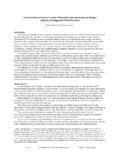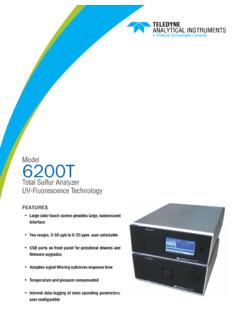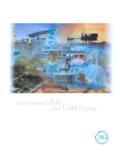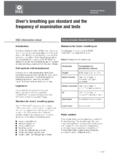Transcription of April 2014 Page 1 of 4 COMMON BREATHING AIR …
1 Air Quality Laboratories, 2014 Page 1 of 4 COMMON BREATHING AIR QUALITY STANDARDS FOR SCBA AND AIRLINESLIMITING CHARTACTERISTICSCGA GRADE Da (2011)CGA GRADE Eb (2011) OSHAc (2011) NFPA 1989d (2013)NFPA 1500e (2013) carbon Dioxide - ppm v/v1000(1)100010001000reference to NFPA 1989 [Sec. ] carbon monoxide - ppm v/v10(1)(2)10105reference to NFPA 1989 [Sec. ] Dew Point ( F) / Water - ppm v/v (3)(3)<-50 / <63(4)<-63 / <24reference to NFPA 1989 [Sec.]
2 ] Odor(5)(5)no noticable odornot pronouncedreference to NFPA 1989 [Sec. ] Oil (condensed) - mg/m3 at NTP & Particulates5(6) 5(6) 52reference to NFPA 1989 [Sec. ] Percent Oxygen balance is predominantly nitrogen - - - - Nitrogen 75 - 81%reference to NFPA 1989 [Sec. ] Total Hydrocarbon Content (as methane) - ppm v/vNA25 NANA reference to NFPA 1989 [Sec.
3 ] Volatile Organic Compounds (VOCs) (non-methane) - ppm v/vNANANA25reference to NFPA 1989 [Sec. ] ApplicationIndustrial Airline or SCBASCUBA DivingGeneral IndustryFirefightingFirefightingSampling Frequencyper supplier / customer agreement [Sec. ]not specified [Sec. (i)(7)] (7)at least quarterly (8) [Sec. ] reference to NFPA 1989 [Sec. ] Sampling Locationsamples shall be representative of air supply [Sec. ]not specified(9) [Sec.
4 ]reference to NFPA 1989 [Sec. ] Testingtested by supplier or laboratory [Sec. ]reference to CGA [Sec. (I)(1)(ii)]lab required [Sec. ]reference to NFPA 1989 [Sec. ] Accreditation / Certificationnot requirednot required required [Sec. ]reference to NFPA 1989 [Sec. ] BREATHING Air Qualityspecified in Table 1reference to 1989 CGA [Sec. (I)(1)(ii)]specified in Sec. to NFPA 1989 [Sec. ] NA = "indicates no maximum limiting characteristic.
5 The absence of a listed quality verification level does not imply that the limitingcharacteristic is or is not present, but merely indicates that the test is not required for compliance with the characteristics specification." CGA 2011 Comparison of Respiratory Protection standards prepared by Air Quality Laboratories, Inc. as a guideline document only. Not intended to replace the official Quality Laboratories, Inc. April 2014 Page 2 of 4 COMMON BREATHING AIR QUALITY STANDARDS FOR SCBA AND AIRLINESOTHER RESPIRATORY PROTECTION PROGRAM REQUIREMENTSCGA GRADE Da (2011)CGA GRADE Eb (2011) OSHAc (2011) NFPA 1989d (2013)NFPA 1500e (2013)Written Programnot specifiedrequired [Sec.]
6 (c)]not specifiedrequired [Sec. ]Written SOPsnot specifiedrequired [Sec. (c)]not specifiedrequired [Sec. ]Medical Evaluation / Certificationnot specifiedinitially then as necessary [Sec. (e)]not specifiedannually [Sec. ]Facepiece Fit Testingnot specifiedinitially then annually [Sec. (f)]not specifiedinitially then annually [Sec. ]Respiratory Protection Trainingnot specifiedinitially then annually [Sec. (k)(5)]not specifiedReference to NFPA 1404 (f) [Sec.
7 ]Respirator Selectionnot specifiedrequired [Sec. (d)]not specifiedrequired [Sec. ]Respirator Cleaning / Storagenot specifiedrequired [Sec. (h)(1) & (h)(2)]not specifiedrequired [Sec. & ]Respirator Inspectionnot specifiedrequired [Sec. (h)(3)]not specifiedrequired [Sec. ]Respirator Maintenancenot specifiedrepairs [Sec. (h)]not specifiedrequired [Sec. ]Cylinder Hydrostatic Testingreference to DOT [Sec.
8 ]reference to DOT [Sec. (I)(4)(I)]not specifiedrequired [Sec. ]Recordkeepingnot specifiedrequired [Sec. (m)]not specifiedrequired [Sec. ]Reference to NFPA 1989not specifiednot specified-----[Sec. ]Comparison of Respiratory Protection standards prepared by Air Quality Laboratories, Inc. as a guideline document only. Not intended to replace the official Quality Laboratories, Inc. April 2014 Page 3 of 4 COMMON BREATHING AIR QUALITY STANDARDS FOR SCBA AND AIRLINES References and Notesa) Compressed Gas Association, Inc.
9 , CGA , Commodity Specification for Air CGA G-7 (Compressed Air for Human Respiration) specifies Grade D as the minimum grade for routine use in self-contained or supplied-air protective BREATHING equipment as used in general industry and ) Compressed Gas Association, Inc., CGA , Commodity Specification for Air CGA G-7 (Compressed Air for Human Respiration) specifies Grade E as the minimum grade to be used for SCUBA diving to 130 ) Occupational Safety & Health Administration, OSHA 29 CFR (6/08/11), Respiratory Protection d) National Fire Protection Association, NFPA 1989 (2013), BREATHING Air Quality for Emergency Services Respiratory Protectione) National Fire Protection Association, NFPA 1500 (2013), Fire Department Occupational Safety & Health Programf)
10 National Fire Protection Association, NFPA 1404 (2013), Fire Service Respiratory Protection Training(1) Not required for synthesized air when oxygen component was produced by air liquefaction & meets USP specification.(2) Not required for synthesized air when nitrogen component was previously analyzed & meets NF specification.(3) The water content of compressed air may vary with the intended use from saturated to very dry. For BREATHING air use in conjunction with SCBA in extreme cold where moisture can condense and freeze causing the BREATHING apparatus to malfunction, a dew point not to exceed -65 F (24 ppm v/v) or 10 degrees Fahrenheit lower than the coldest temperature expected in the area is required.






